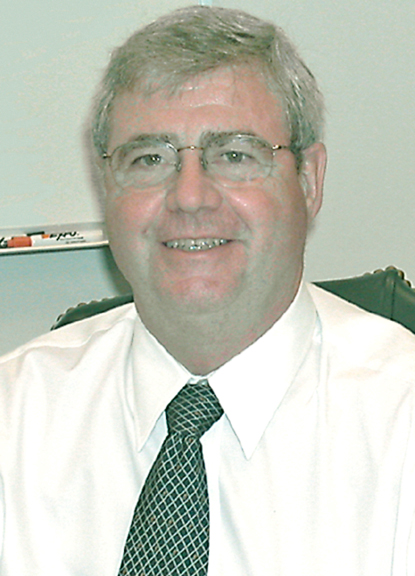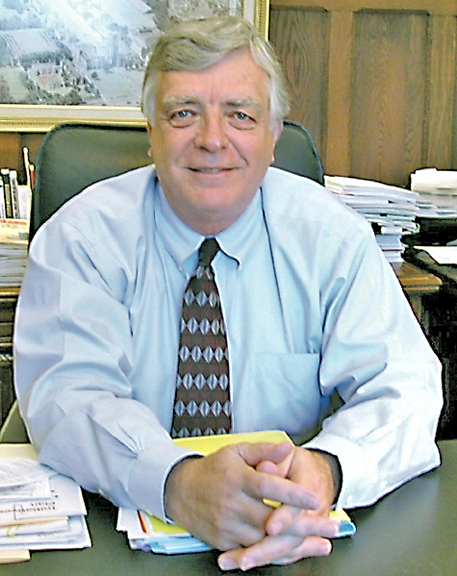
As published in the October 1, 2006 Toledo Business Journal


Peter Kay & Dan Johnson
Northwest Ohio Science and Technology Corridor
Science and Technology
Corridor
development
under way
Toledo Business Journal recently interviewed Peter Kay, director of the Northwest Ohio Science and Technology Corridor, and UT President Emeritus Dan Johnson, originator of the Science and Technology Corridor. They shared the following thoughts.
Toledo Business Journal: You are working to develop a Science and Technology corridor along Westwood Avenue between the University of Toledo and the former MUO campus. Can you discuss the resources available to your organization?
Dan Johnson: The resources that we now have available are coming primarily from the University of Toledo in the form of basic staff support for the director, graduate assistants, and secretarial help. My time is also going to be contributed to that… We will have a board of directors within the next few weeks, and I will be a member of the board.
Peter Kay: The resources are to run this office. But, to do our mission, our approach to date will be to get cooperative ventures going and facilitate organizations and entities that are already in place doing their part of the mission. Rather than create a new organization, it’s much better to help people any way we can to facilitate what is already going on. The mission for a concentration on high-technology businesses will involve the UT office of research and their internal office of intellectual property. It will involve the MUO foundation, which had some land here, the engineering school, and the business school – and that’s just within UT. We work closely with the Regional Growth Partnership (RGP), the Port Authority, the City, and the County. So, there’s a whole network of people that have been working on these things. And we hope to take that to a higher level by offering our time and assistance to see how we can facilitate this collectively. It’s good because more people are aware of what’s going on, you get a bigger network going, and more success.
TBJ: Can you update the status and plans for the facility in the former EISC building / Clean and Alternative Energy Incubator at Dorr and Westwood?
PK: Before I was hired, Frank Calzonetti, who is vice president of research and development for UT, was setting the building up to operate as a technology business incubator. Concentrating on alternative energy, and more specifically on photovoltaic cells, we’ve had a lot of success. In fact, he tells me that UT has a national, if not international, lead position in certain aspects of photovoltaic solar panels.
So, what’s happening with that building right now is that we have three businesses: two are spinoff startups from UT, and the other is a new company in early stages that is a fabricator of custom-made solar panel mounting equipment.
It’s working well. It’s trying to concentrate people, the research, and the businesses in there. There’s still more room in the incubator, so we’re still looking for more tenants. Frank [Calzonetti] has just hired a person to act as the full time professional incubator / manager. And the role of that person is to work with the companies that are in there on a daily basis to provide them whatever help they need. Not necessarily just with technology, but with everything that goes with running a business.
At the same time, we have plans afoot to acquire funding to build a second building. That’s in an early stage. It would be a building of roughly the same size, located very close to the first building.
That will take, in the best of timing, a year or a year and a half to come to fruition. But, it will take another 12 months to get the existing building fully occupied. So, the timing is intended to be such that, as soon as the existing one is occupied we will try to have the second one come on-line so we have a continual availability. And the same director can run both.
DJ: I think this is one of the key areas for the Corridor: to work in support of the University’s efforts to incubate spinoff companies to attract startups here that would see some advantage in working closely with the scientists in the technology area. So, it’s a powerful mix. Having it right here gives them a real advantage.
PK: Logically, what makes sense is to have space available in close proximity, especially for startup companies, to the engineering and physical sciences and have more space in close proximity to the medical school and the biosciences for companies that are in that field. Scott Park has a lot of future availability for constructing the next level of collaboration, like an accelerator type building. Or, it could also become a center of technology in the middle of this whole corridor.
Because of the practical limits of the resources available, we can’t go out and build hundreds of thousands of square feet on spec without tenants.
TBJ: Can you address key elements of the strategy plan for the Science and Technology Corridor project?
DJ: One of the first things that we’re going to ask the board of directors to do is review the draft of a strategic plan that Peter [Kay] has developed. There are some key elements that we know will be in that plan. One of them is incubation, another is site-ready properties for facilities related to science and technology-based industries. Third will be strengthening the level of collaboration of partners in the area; we have memoranda of agreement with many area organizations, including Owens Community College, Bowling Green State University (BGSU) and some of the other entities here.
Our academic and research institutions in northwest Ohio are bringing in $100 million a year in outside funding, and every year that figure is growing. That money is not being leveraged to the full extent of economic diversity and economic development. So, that’s what we see as the primary objective here. The thing that we do from a strategic point of view is help leverage that research that’s going on in our institutions to a higher level of economic development, [to bring] new companies and diversity, and to help bring the new knowledge economy here in a significant way. And we have the educational base to do that, but we have to create the infrastructure before that can be successful.
TBJ: Can you discuss near-term opportunities for any potential projects involving the Corridor?
DJ: Just recently, we had preliminary conversations with two companies. A company here in Ohio has expressed interest in coming to Toledo. It was a very encouraging conversation that resulted in a second meeting with a company involved in software development related to the health field. It’s an exciting prospect given the mission of the institution now, with health being one of the major objectives of the UT / MUO merger.
There are a number of large-scale and small-scale operations that we’ve worked with over the past six months that want to be located in the Corridor. We have been bringing them in contact with the kinds of researchers, facilities, and services that they need to be successful. We’re excited about some of them possibly deciding to locate here.
PK: For a few months we’ve been working with a company called Platform Lab. It is a non-profit organization created for the sole purpose of administering a $1.1+ million grant from the State under the Third Frontier program. Their mission was to create four nodes around the State that provided extremely large broadband connection directly to the Ohio Supercomputer.
The key element here, according to their own operational rules, was that they had to have a minimum commitment of $40,000 worth of time used on their system. So they would sell their services to companies for testing of software that required huge bandwidth.
Companies over a certain size are required to have disaster recovery plans. There are two choices… One is to purchase expensive equipment to do the real-time test. Another is to rent time at outside sites to do the testing, which can cost around $100,000. Platform Lab, because of their structure and connection with the Supercomputer can offer the same test for around $12,000. It’s a huge benefit to companies.
It’s scheduled to open on campus this month. We edged out Cincinnati because we were able to put up $30,000. This is a high-tech service that will help our companies and our region and also illustrate the Corridor’s role in collaborating with other agencies like the RGP and Platform Lab. It shows the success of our approach.
TBJ: What role does transportation to and from the Corridor play, and are there plans for the rail line in proximity to the Corridor?
DJ: One of the first ideas that we had that helped stimulate the notion of the Corridor was to use the CSX rail as a connection through both the main campus and the health campus. The concept is to begin linking these assets together over the long-term. We’ve had extensive conversations with Marcy Kaptur and even Governor Bob Taft.
The Metroparks are interested in having a [north / south oriented] bike path similar to the one that goes through Ottawa Hills. TMACOG is working on our behalf with CSX.
In addition to the physical Corridor, we have looked at transportation systems. For example, Frazer-Nash, in London, has developed a system called Metrail. It’s a hybrid, high-speed rail system that operates off solar power electricity. So it’s about a fourth or less the cost of electric systems.
This is very interesting because of our interest in solar power. We’ve been in preliminary discussions with Frazer-Nash about Toledo possibly being a beta site for the company. That’s a long-term discussion, but if we were to get into the system, we would have some people from our engineering school make sure it meets American standards from a quality point of view. The cost of this system is considerably less than a lot of the other systems. This would also bring people to Toledo to see the system and learn how it operates.
If we do get a beta system and it becomes something that other American cities are interested in, we want the assembly plant right here in Toledo. Whether this will happen, I don’t know, but this is the kind of discussion we want to have so people realize that things can happen in Toledo.
This would really represent a futuristic look for Toledo and symbolically represent the region’s logistics. Because of the fact that it’s solar powered, we could be testing new materials to help refine this product.
PK: There’s future expansion possibilities for this system outside the Corridor itself to connect the Toledo area.
TBJ: Is there a role that private sector leaders and private sector companies can play in the plan for the Science and Technology Corridor?
PK: The board itself will be largely private sector. The Corridor can create a bridge between businesses and the universities… Neither the University nor the business sector can effectively lead this process because their cultures are very different and they have different focuses. The Corridor could come in there and help facilitate that process. The private sector is integral for us to get the effect we’re looking for regarding the economy of the region.
DJ: The whole purpose is to help develop the private sector knowledge economy. So, we’re trying to use the publicly supported assets that we have to stimulate more rapid expansion in science and technology-based businesses.